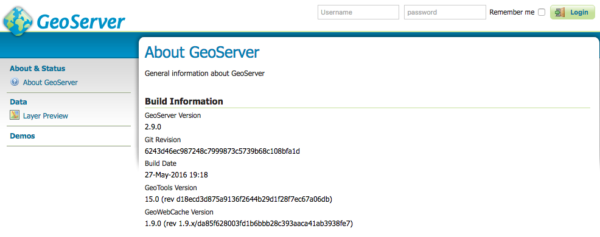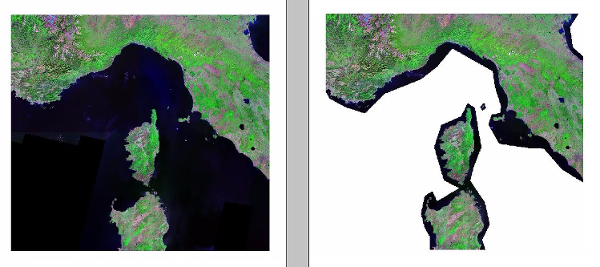GeoServer Blog
Talks about GeoServer in FOSS4G Bonn
_Guest post by Fernando Quadro: _FOSS4G is the annual global event of the Open Source Geospatial Foundation (OSGeo). Although widely recognized as the largest technical open source geospatial conference we call FOSS4G an “event” because it is far more than “just” a conference. A typical FOSS4G will include regular presentations and talks, but also code sprints, birds of a feather sessions, workshops, topic talks and of course social events spanning all nine days.
The list of talks that will be presented are already published, here are the talks about GeoServer:
-
Creating Stunning Maps in GeoServer: mastering SLD and CSS styles - Andrea Aime (GeoSolutions)
-
GeoServer Styling Hints and Tips for Prettier Maps - Ian Turton (Astun Technology)
-
Enterprise Single Sign-On in GeoServer: where do we stand? - Francesco Bartoli (Geobeyond Srl)
-
GeoServer in Production: we do it, here is how! - Simone Giannecchini and Andrea Aime (GeoSolutions)
-
Mastering Security with GeoServer and GeoFence - Alessio Fabiani and Simone Giannecchini (GeoSolutions)
-
Serving earth observation data with GeoServer: addressing real world requirements - Simone Giannecchini and Andrea Aime (GeoSolutions)
-
Crunching Data In GeoServer: Mastering Rendering Transformations, WPS Processes And SQL Views - Andrea Aime (GeoSolutions)
-
State of GeoServer - Jody Garnett (Boundless) and Andrea Aime (GeoSolutions)
-
Vector Tiles with GeoServer and OpenLayers - David Blasby and Andreas Hocevar (Boundless)
-
Open Source strategies in a federal office - migrating from closed software to OS development - Dr. Marco Lechner (German Federal Office for Radiation Protection)
-
Still waiting for someone else to do it: Writing documentation for an open source project - Mike Pumphrey (Boundless)
-
State of GeoGig - Gabriel Roldán and Tyler Battle (Boundless)
-
Using Open Source Tools to Visualize Spatial Activity Drone Restrictions - Aäron Trippaers
-
Bringing benthic data to the surface - moving Marine Recorder into an open source spatial database - James Hutchison (Joint Nature Conservation Committee)
-
Real-time large format maps for passenger information on railway disruptions - Mario Härtwig (geOps)
-
Collect & Manage Geospatial Data Edits with GeoSHAPE - Syrus Mesdaghi (Prominent Edge LLC)
-
Urban SDG Measuring System using the Open Geospatial Data of the International Organizations - Junyoug Choi (Spatial Information office), Hyunsoo Kim (CITUS. CO), Jaeseong Ahn (Kyungil University)
The workshops are include great GeoServer content:
-
Web mapping with OGC services and GeoServer: an introduction - Andrea Aime and Simone Giannecchini (GeoSolutions)
-
Beyond GeoServer Basics - Mike Pumphrey and Morgan Thompson (Boundless)
-
GeoServer Styling Workshop - Jody Garnett, Kevin Smith and Torben Barsballe (Boundless)
-
I have data with TIME, ELEVATION and other dimensions: what can GeoServer do for me? - Simone Giannecchini and Andrea Aime (GeoSolutions)
-
Enterprise class deployment for GeoServer and GeoWebcache: Optimizing performances and robustness - Daniel Koch, Nils Bühner and Andre Henn (terrestris GmbH & Co. KG) and Simone Giannecchini (GeoSolutions)
FOSS4G 2016 takes place between August 24th and 27th in Bonn Germany. For more information see the video below:
GeoServer 2.9.0 Released
The GeoServer team is overjoyed to announce the GeoServer 2.9.0 release. Downloads are available (zip, war, dmg and exe) along with docs and extensions. We will be working with OSGeo to provide a signed DMG download shortly.
This release is made by Jody Garnett (Boundless) and Devon Tucker (Boundless) with help from Andrea Aime and Alessandro Parma (GeoSolutions) in conjunction with the GeoWebCache 1.9.0 and GeoTools 15.0 releases.
| For more information on this release check the release notes (2.9.0 | RC1 | beta2 | beta, M0). |
Highlights
As this is a major release GeoServer 2.9.0 includes a number of important changes, including both new features and compatibility requirements.
Java 8 Required
This release requires the use of Java 8, and is compatible with both Oracle JDK and Open JDK.
Servlet 3 Required
Due to internal upgrades GeoServer now requires a Servlet 3 compatible application server.
-
The standalone downloads for Mac, Windows and Linux has been update to Jetty 9.2.13
-
Tomcat users will be required to upgrade to Tomcat 7 or newer (for those doing a WAR install)
Web Administration
A number of improvements and clarifications have been made to the web administration application:
-
The Layers and Layer Preview has been restructured to lead with layer title in the first column, layer workspace and name combined into the second column. By popular request these pages now use layer (rather than resource) actions with “Add a new layer”, and “Remove selected layers”.
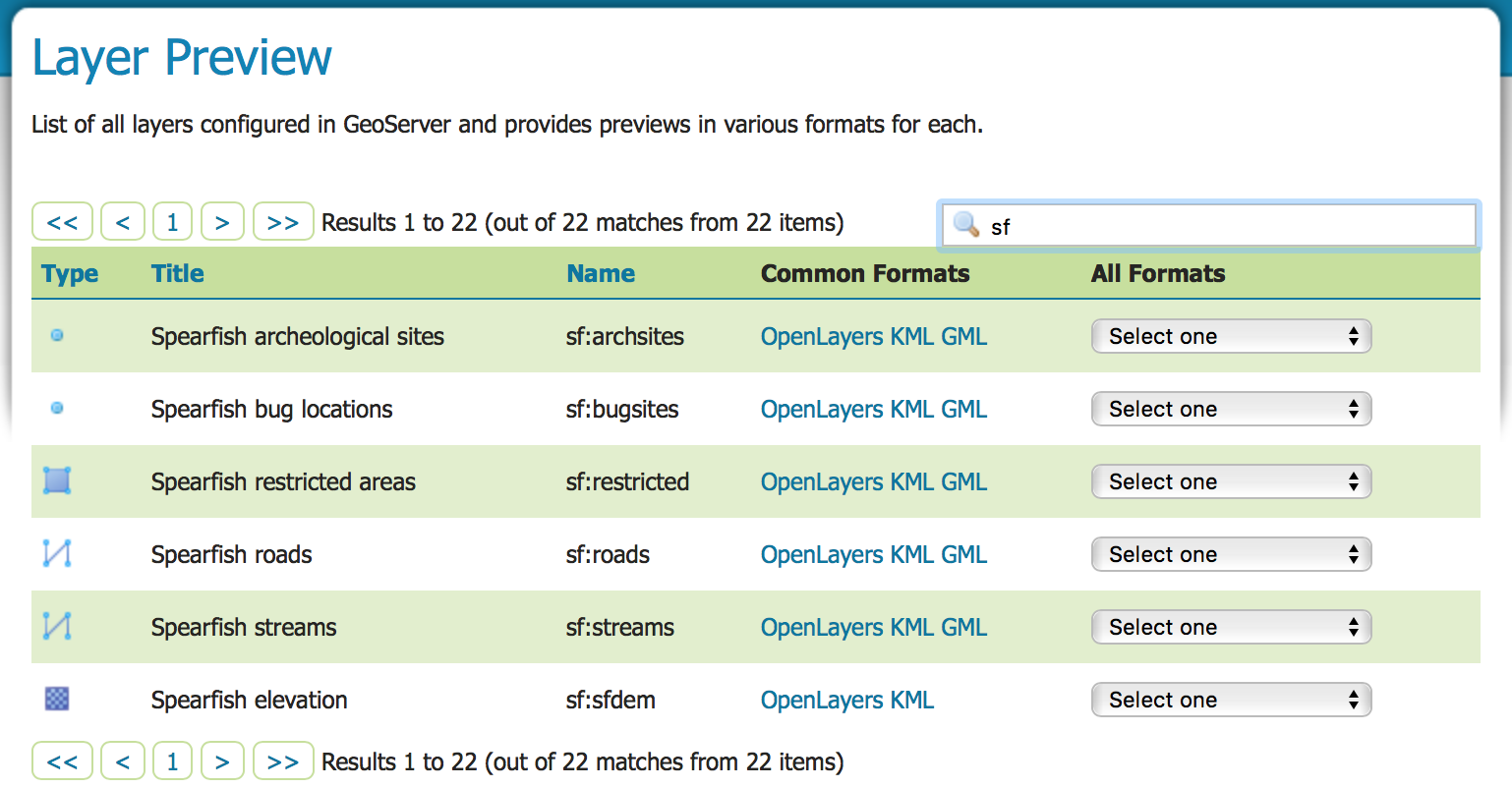
-
You can now generate layer bounds from either the data bounds or from the spatial reference system bounds. This is handy for dynamic layers that will have content added to them over time.

-
Styles can now include an optional legend graphic for use in WMS GetCapabilities.
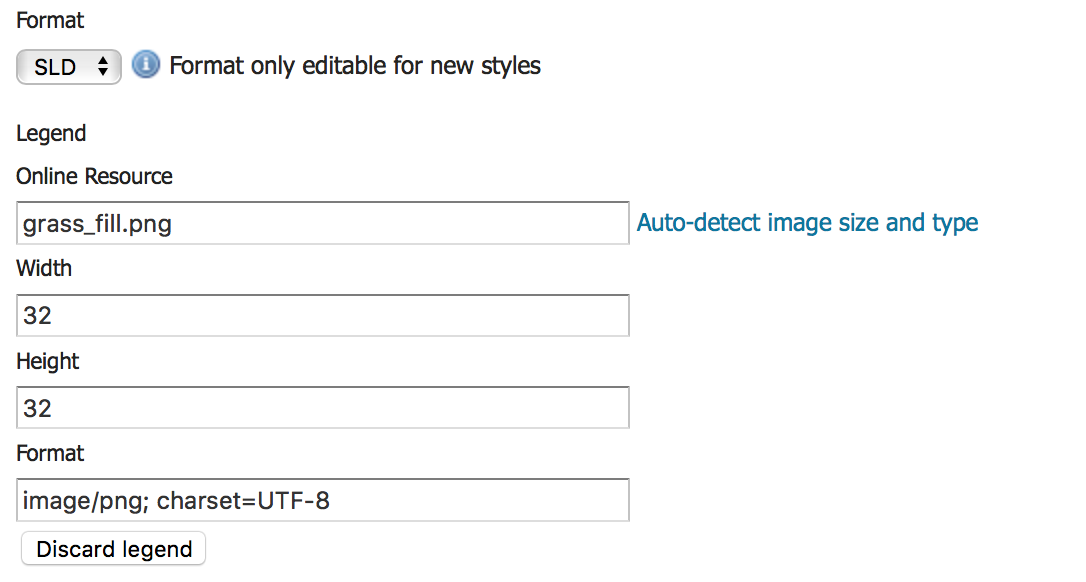
-
Global Settings have been grouped into a section for configuration of web services and a section for internal settings (affecting the GeoServer application as a whole).
-
Image Processing and Raster Access are clearly presented with controls for memory and CPU use. Previously these screens were expressed in terms of the internal components used.

User Guide
The user guide has been restructured:
-
The document layout has been reduced to a smaller number of sections
-
Data management covers vector, raster, database and web services along with common settings
-
Services (WMS, WFS, WCS, WPS, CSW) have been gathered into a single section for consistency, even though WPS is an optional install.
-
-
The duplication between service description and application configuration has been resolved:
-
Each Service is described, both in terms of functionality, alongside details on how the service is configured
-
The Web administration interface section remains focused on on application configuration, linking to to service configuration above (to prevent duplication).
-
-
Tutorials have been gathered into a single location.
Resource REST API
A new feature for GeoServer 2.9 is the ability to manage resources (icons, fonts, configuration files) via the REST API. This approach works with both the default file based GeoServer configuration and JDBCConfig community module.
-
**GET: rest/resource/styles/grass_fill.png?
 **
** -
GET: rest/resource/styles/grass_fill.png?operation=metadata&format=json
{ ”ResourceMetadata”: { “name”: “grass_fill.png”, “parent”: { “path”: “/styles”, “link”: { “href”: “http://localhost:8080/geoserver/rest/resource/styles”, “rel”: “alternate”, “type”: “application/json” } }, “lastModified”: “2016-05-27 19:31:30.0 UTC”, “type”: “resource” } }
About/Status REST API
The about REST API already reports on the jars installed and the version of high-level components. GeoServer 2.9 includes the addition of about/status which reports not only what components are installed, but if they are correctly functioning. We will be working with this endpoint in subsequent releases to better reporting on GeoServer installation status.
- GET rest/about/status
Offset line support
Symbology Encoding 1.0 offset line is now supported, along with a vendor extension to use the same in SLD 1.0, and CSS support via the “stroke-offset” property. Here are a couple of screenshots of the effects that can be achieved by using offset line.
UTFGrid support in WMS and WMTS
GeoServer WMS and WMTS now support UTFGrid as an output format, to get fast and rich feature info on the client side. The WMS output has been tested with OpenLayers 2 by applying this patch, while not officially tested it should also work with OpenLayers 3 and Leaflet using the appropriate URL templates against the WMTS output.
Improved WPS aggregation process with group by
The Aggregate process has been improved to support group-by against any data source, with the ability to turn the execution in an efficient SQL with group by query, if the underlying data source is a database. In case of group-by a rich JSON output is generated, than can then be used to drive client side libraries such as D3 to generate nice charts for your users:
{
"GroupByAttributes": [ "groupingAttribute" ],
"AggregationResults": [
[ "Class1", 18 ],
[ "Class2", 1 ],
[ "Class3", 3 ],
[ "Class4", 3 ]
],
"AggregationFunctions": [ "Count" ],
"AggregationAttribute": "countingAttribute"
}
Vector masking support for GDAL based formats
All GDAL based formats now support vector masks to cut NODATA areas away from rendering, similar to what image mosaic already supported. Here is a sample, cutting away some areas from a JPEG 2000 image (the format adds compression artifacts at the border, thus the input transparent color cannot be used to achieve a similar effect).
Internal Upgrades
Internally GeoServer has received a number of important upgrades:
-
Update to Spring 4: The upgrade to Spring 4 is responsible for the delay of the GeoServer 2.9 and was required for Java 8 compatibility. This upgrade was far reaching with both the REST-API and Security integration requiring a concerted quality assurance effort on geoserver-devel. This upgrade was technically challenging resulting in a delay to the 2.9 release schedule. Thanks to everyone who helped out, beta testers, and Justin, Andrea and Niels for tackling the harder issues.
-
Upgrade to JAI-EXT to 1.0.9: To enable JAI-EXT use startup parameter org.geotools.coverage.jaiext.enabled=true (for more information see Image Processing in the user guide).

-
**Upgrade to Wicket 7: **The web administration application has been updated to use the latest Wicket library, thanks to a larger team effort. We would like to thank the sponsors of the Wicket 7 upgrade sprint: OSGeo, Boundless, Vivid Solutions, How 2 Map, San Jose Water Company, Transient, Geobeyond (with in-kind sponsors GeoSolutions, CCRi, Astun Technology and Voyager).
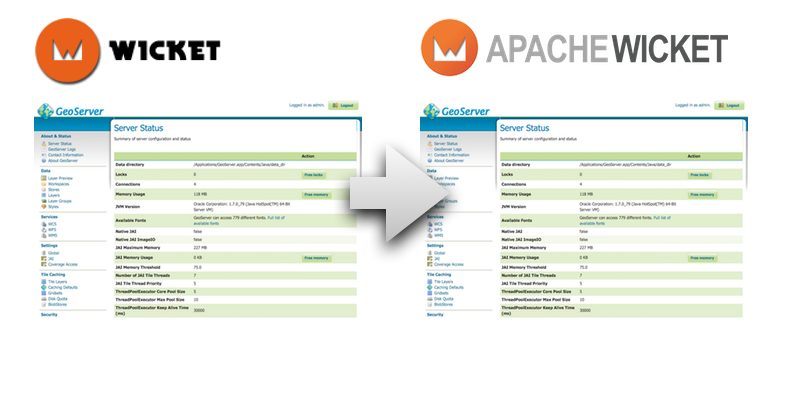
-
The GeoServer default data directory has been updated with titles and descriptions for many layers (to better take advantage of the user interface improvements). The previously disabled Pk50095 layer (shown below) is now enabled by default.
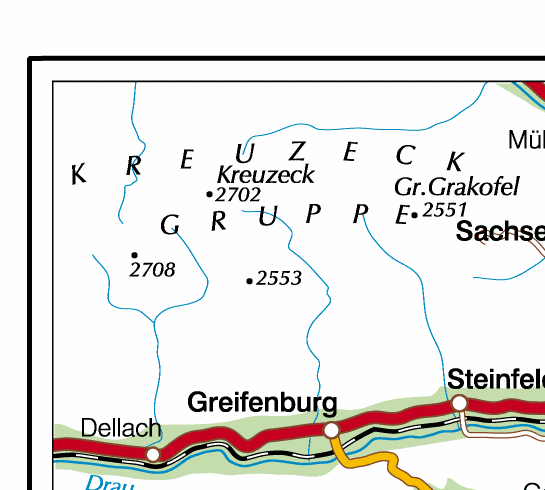
About GeoServer 2.9
Articles, docs, blog posts and presentations:
-
Internals upgrade to spring-4 for Java 8 compatibility (User Guide)
-
GeoServer code sprint success and wicket migration code sprint (GeoServer Blog)
-
GeoServer Plugin for QGIS (Boundless)
-
Simplify complex feature mappings setup with HALE (GeoSolutions)
-
REST management of Resources (User Guide)
##
GeoServer 2.9-RC1 Released!
The GeoServer team is pleased to announce GeoServer 2.9-RC1. Downloads are available (zip, war, dmg and exe) along with docs and extensions.
This release is made by Torben Barsballe (Boundless) in conjunction with GeoWebCache 1.9-RC1 and GeoTools 15-RC1.
This is a release candidate for final testing before we release 2.9.0.
Highlights:
-
This release requires Java 8 and is compatible with Oracle JDK and OpenJDK
-
GeoServer now requires Servlet 3 (so Tomcat 7 or newer if you are doing a WAR install)
-
Update to Spring 4 and JAI-EXT to 1.0.9
-
For more information, check the 2.9-beta, 2.9-beta2, and 2.9-M0 release notes.
Fixes since beta:
-
Web interface does not reflect workspace specific WPS enabled/disabled properly
-
Enabling WPS for a workspace doesn’t appear on the GUI after reload
-
Restricting security on layers breaks aggregate visitor optimizations in JDBC stores
-
Stacktrace when modifying the configuration of a WMS Cascade layer
-
Update jetty version used by windows installer service wrapper
-
PDF generation can contain invalid polygons whose fill bleeds out in the whole map
For more information see 2.9-RC1 release notes.
We would like to thank the sponsors of the Wicket 7 upgrade sprint: OSGeo, Boundless, Vivid Solutions, How 2 Map, San Jose Water Company, Transient and Geobeyond (with in-kind sponsors GeoSolutions, CCRi, Astun Technology and Voyager).
About GeoServer 2.9
Articles, docs, blog posts and presentations:
-
Internals upgrade to spring-4 for Java 8 compatibility
-
GeoServer code sprint success and wicket migration code sprint
-
REST configuration Resources (docs)
GeoServer Community
GeoServer Community modules provide an area for ideas and experimentation. Community highlights for this release:
- Community YSLD: The YSLD styling language provides a more concise alternative to SLD, while still sharing the same structure.
Community modules should be considered a work-in-progress and are subject to quality assurance, documentation IP checks and a maintainer before being considered ready for release.
GeoServer 2.9-beta2 released
The GeoServer team is pleased to announce the release of GeoServer 2.9-beta2. The previous 2.9-beta discovered an incompatibility with Java 8, resulting in a bit of emergency planning and a delay to the 2.9.0 release schedule.
Download bundles are available (zip, war, dmg and exe). A reminder that beta releases are intended for public feedback and are not recommended for production use.
Highlights:
-
This release requires Java 8 and is compatible with Oracle JDK and OpenJDK
-
GeoServer now requires Servlet 3 (so Tomcat 7 or newer if you are doing a WAR install)
-
Negative-date now supported (for GeoNode compatibility)
-
New REST API for installation status
-
For more information check the release notes for beta2 (history beta1 M0) - Update to Spring 4 and JAI-EXT to 1.0.9
This 2.9-beta2 release is released in conjunction with GeoTools 15-beta2 and GeoWebCache 1.9-beta2. Thanks to Jody Garnett (Boundless) and Kevin Smith (Boundless) for this release.
Beta Testing
The GeoServer Team has been hard at work to bring you this beta release. Thanks to the committers for taking part in the emergency spring-4 upgrade and community members joining for subsequent testing and quality assurance: Justin Deoliveira and Andrea Aimie, Emanuele Tajariol, Damiano Giampaoli, Ben Caradoc-Davies, Niels Charlier, Mauro Bartolomeoli, Jody Garnett, Jukka Rahkonen, Brad Hards, Kevin Smith, Chris Snider, Torben Barsballe, Christian Mueller, Luigi Pirelli … and next you!
Here is our priorities for testing:
-
Seeking confirmation on Java 8 compatibility (test Oracle JDK and OpenJDK on a range of platforms)
-
Testing of the user-interface (although the team has performed extensive manual testing we need your help)
-
Release packaging (check for anything out of date, any issues starting up)
-
GeoServer security integration
We have a couple known issues to keep in mind when testing:
-
Windows installer “Install as service” needs a configuration change once installed (GEOS-7507) Open wrapper.conf and update contents with: wrapper.app.parameter.1=org.eclipse.jetty.start.Main
-
Windows installer “Run manually” may have an issue with startup.bat (GEOS-7509)
-
Several issues have been reported with the Demo Page (GEOS-7513)
About GeoServer 2.9
Articles, docs, blog posts and presentations:
-
Internals upgrade to spring-4 for Java 8 compatibility
-
GeoServer code sprint success and wicket migration code sprint
-
REST configuration Resources (docs)
The GeoServer team extends our thanks to wicket upgrade sprint sponsors: OSGeo, Boundless, Vivid Solutions, How 2 Map, San Jose Water Company, Transient and Geobeyond.
GeoServer 2.8.3 released
The GeoServer team is pleased to announce the release of GeoServer 2.8.3. Download bundles are provided (bin, war, dmg and exe) along with documentation and extensions.
GeoServer 2.8.3 is the latest stable release of GeoServer and is recommended for production deployment. This release is made in conjunction with GeoTools 14.3. Thanks to all contributors. Fixes and new functionality include:
-
A few security subsystem related fixed, DescribeFeatureType and layer preview now works with mixed security mode, new layer groups can be edited when using GeoFence, mixing layer groups and layers with other styles in a GetMap request now works with GeoFence too, it’s possible to access workspace specific services when security only allows access to some layers of it (but not the full workspace), embedded GWC can now serve layer groups when “data security” is enabled
-
WFS cascading related fixes, the WFS store does not get disabled on restart anymore, and can handle straight line elements embedded in a curve container,
-
WFS server received GML3 encoding fixes for geometries with 3D coordinates and pure geometry collections
-
Fixed regression with configuration of SQL Views having multiple geometry fields
-
WPS can now be enabled/disabled per workspace properly
-
And much more, see all the 34 tickets resolved in the release notes
Thanks to Andrea Aime (GeoSolutions) for this release.
About GeoServer 2.8
Articles, blog posts and presentations:
-
State of GeoServer 2015 (FOSS4G)
-
XEE Vunerability (GeoServer)
-
Remote Execution Vulnerability (GeoServer)
-
Z ordering features within and across feature types and layers (User Manual)
-
JAI-Ext, the Open Source replacement for Oracle JAI (GeoSolutions)
-
Customizable arrow in GeoServer (GeoSolutions)
-
PostGIS Curve Support (GeoSolutions)
-
Improved NetCDF/GRIB support in GeoServer (GeoSolutions)
-
Initial GeoServer 2.8.0 release announcement (GeoServer)

